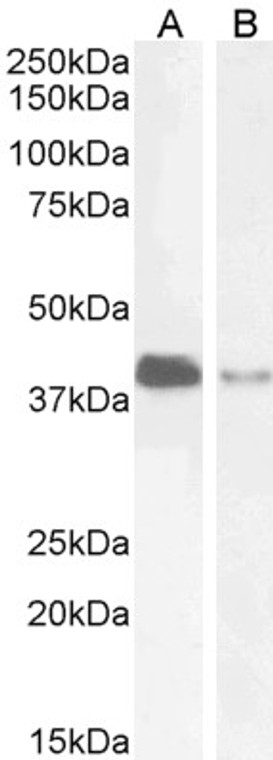| Host: |
Goat |
| Applications: |
Pep-ELISA/WB/IHC/FC |
| Reactivity: |
Human |
| Note: |
STRICTLY FOR FURTHER SCIENTIFIC RESEARCH USE ONLY (RUO). MUST NOT TO BE USED IN DIAGNOSTIC OR THERAPEUTIC APPLICATIONS. |
| Short Description: |
Goat polyclonal antibody anti-PAR6alpha/PARD6A (C-Term) is suitable for use in ELISA, Western Blot, Immunohistochemistry and Flow Cytometry research applications. |
| Clonality: |
Polyclonal |
| Conjugation: |
Unconjugated |
| Isotype: |
IgG |
| Formulation: |
0.5 mg/ml in Tris saline, 0.02% sodium azide, pH7.3 with 0.5% bovine serum albumin. NA |
| Purification: |
Purified from goat serum by ammonium sulphate precipitation followed by antigen affinity chromatography using the immunizing peptide. |
| Concentration: |
0.5 mg/mL |
| Dilution Range: |
WB-1-3µg/mlIHC-10µg/mlFC-Flow cytometric analysis of Jurkat cells. 10ug/mlELISA-antibody detection limit dilution 1:8000. |
| Storage Instruction: |
Store at-20°C on receipt and minimise freeze-thaw cycles. |
| Gene Symbol: |
PARD6A |
| Gene ID: |
50855 |
| Uniprot ID: |
PAR6A_HUMAN |
| Immunogen Region: |
C-Term |
| Accession Number: |
NP_058644.1; NP_001032358.1 |
| Specificity: |
This antibody is expected to recognise both reported isoforms (NP_058644.1; NP_001032358.1). |
| Immunogen Sequence: |
GSRIRGDGSGFSL |
| Post Translational Modifications | Phosphorylated by the TGF-beta receptor. |
| Function | Adapter protein involved in asymmetrical cell division and cell polarization processes. Probably involved in the formation of epithelial tight junctions. Association with PARD3 may prevent the interaction of PARD3 with F11R/JAM1, thereby preventing tight junction assembly. The PARD6-PARD3 complex links GTP-bound Rho small GTPases to atypical protein kinase C proteins. Regulates centrosome organization and function. Essential for the centrosomal recruitment of key proteins that control centrosomal microtubule organization. |
| Protein Name | Partitioning Defective 6 Homolog AlphaPar-6Par-6 AlphaPar-6aPar6cTax Interaction Protein 40Tip-40 |
| Database Links | Reactome: R-HSA-2173791Reactome: R-HSA-420029Reactome: R-HSA-4608870Reactome: R-HSA-9013148Reactome: R-HSA-9013149Reactome: R-HSA-9013420Reactome: R-HSA-9013424 |
| Cellular Localisation | CytoplasmCell MembraneCell ProjectionRuffleCell JunctionTight JunctionCytoskeletonMicrotubule Organizing CenterCentrosomeCentriolar SatelliteColocalizes With Gtp-Bound Cdc42 Or Rac1 At Membrane Ruffles And With Pard3 And Prkci At Epithelial Tight JunctionsRecruited To The Centrosome By A Microtubule And Dynein-Dynactin-Dependent Mechanism |
| Alternative Antibody Names | Anti-Partitioning Defective 6 Homolog Alpha antibodyAnti-Par-6 antibodyAnti-Par-6 Alpha antibodyAnti-Par-6a antibodyAnti-Par6c antibodyAnti-Tax Interaction Protein 40 antibodyAnti-Tip-40 antibodyAnti-PARD6A antibodyAnti-PAR6A antibody |
Information sourced from Uniprot.org
12 months for antibodies. 6 months for ELISA Kits. Please see website T&Cs for further guidance









